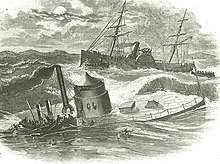Graveyard of the Atlantic
Graveyard of the Atlantic is a nickname for the treacherous waters and area of numerous shipwrecks off the Outer Banks of North Carolina, United States, which are due to the coast's shifting sands and inlets. To a lesser degree, this nickname has also been applied to Sable Island off of Nova Scotia, Canada, as well as the waters off Cape Cod, Massachusetts, United States.
Outer Banks

Along the Outer Banks, navigational challenges posed by the
Among the better known
The Graveyard extends along the whole of the North Carolina coast, northward past Chicamacomico, Bodie Island, and Nags Head to Sandbridge Beach, and southward in curving arcs to the points at Cape Lookout and Cape Fear.[7] This spot is known as Cape Point, which is the stretch of beach that divides Hatteras Island's north- and south-facing beaches. It is a very famous spot on the east coast, despite its fragile location. Cape Hatteras has been a deadly trap for sailors that have entered over the centuries. The stretch of shore is home to more than 600 shipwrecks off the shifting sandbars of the Hatteras Islands.[4] The sandbars shift due to rough waves and unpredictable currents. Another danger was the Outer Banks "wreckers." Some residents of the Outer Banks, known as wreckers, made part of their living by scavenging wrecked ships—or by luring ships to their destruction.[8] Horses with a lantern tied to their neck would be walked along the beach. The lanterns' up and down motion would appear to other ships to represent clear water and a ship ahead. The unsuspecting captain would then drive his ship ashore following the false light.[9]
During
Sable Island
The title "Graveyard of the Atlantic" is also applied to Sable Island, a narrow crescent of sand that lies 300 km southeast of Halifax, Nova Scotia. There have been over 350 recorded shipwrecks[12] since HMS Delight in 1583.[13]
People believe that the island was first discovered in the 1520s by the European explorer João Álvares Fagundes, who named it Fagundes, but the name was changed by the French at the end of the 16th century to île de Sable, which means Sand Island. The island is little more than a 40 km long sandbar, although it does have a number of fresh water ponds.[14] It is only 1.5 km wide at its widest; the highest point on the island is approx 30 metres tall.
Rev.
In the age of sail, the danger of Sable Island was due to the shifting sand bars that surround it, and the thick fog in the area due to the close proximity of the cold
Due to the strange (and mostly uninhabited) location of Sable Island, Guglielmo Marconi made it an outpost for radio communication experimentation. In 1901, Marconi thought this Atlantic island would be a good location for a wireless station for transatlantic communication.[19]
Cape Cod

The Lower Cape and Outer Cape sections of Cape Cod have also sometimes been called The Graveyard of the Atlantic or similar appellations.[20] About 3,000 shipwrecks have occurred there in recorded history.[21]
See also
References
- ^ Grussing, Valerie J. "Reanimating the Graveyard: Heritage Tourism Development of North Carolina Shipwrecks" (PDF). thescholarship.ecu.edu. Retrieved 18 July 2015.
- ^ "NOAA's National Ocean Service".
- ^ Ingram, Hunter. "Lost at sea? The tragic mystery of Theodosia Burr Alston". Wilmington Star News. Retrieved 2020-07-26.
- ^ a b (2008). Graveyard of the Atlantic. http://www.ncbeaches.com/Features/History/GraveyardOfTheAtlantic
- ^ "North Carolina Shipwrecks: The Spanish Galleons ~ 18 August 1750". 6 January 2012.
- ^ "El Salvador". Intersal, Inc.
- ^ Stick, D. (1981). Graveyard of the Atlantic. North Carolina, The University of North Carolina.
- ^ "Archived copy". Archived from the original on 2016-04-05. Retrieved 2015-03-26.
{{cite web}}: CS1 maint: archived copy as title (link) - ^ a b Hopewell, John (September 13, 2016). "These Ships are Resting Just Off the Outer Banks in the Graveyard of the Atlantic". The Washington Post.
- ^ Morgenstein, Mark (30 October 2012). "Famed ship sinks off North Carolina; two crew missing". CNN. Retrieved 2012-10-29.
- ^ "Fishing Boat Slowly Sinking Into the Sand After Running Aground off North Carolina's Outer Banks". The Weather Channel. Retrieved 2020-07-26.
- ^ "Maritime Museum of the Atlantic – Sable Island". 14 February 2013.
- ^ "Marine Heritage Database: HMS Delight".
- ^ a b Keddy, V (2008). Mysteries of Canada. http://www.mysteriesofcanada.com/Nova_Scotia/sable_island.htm
- ^ "The Nature of Things".
- ^ "Parks Canada". 16 October 2020.
- ^ "A Brief History of Sable Island".
- ^ "Lighthouses of Nova Scotia".
- ^ "National Marconi Day". Facebook. Archived from the original on 2022-02-26.
- ^ "Cape Cod's reputation as a graveyard of menace to mariners". Cape Cod Times. August 22, 1999. Retrieved April 25, 2024.
Amy Whorf McGuiggan (May 19, 2021). "A Life-Saving Beacon in the Fog of Politics". Provincetown Independent. Retrieved April 25, 2024.
"Maritime History at Cape Cod National Seashore". United States National Park Service. Retrieved April 25, 2024.
"The "Ocean Graveyard" is Filled With Cape Cod Shipwrecks". CapeCod.com. February 4, 2019. Retrieved April 25, 2024.
Catherine Kozak (March 8, 2010). "What's in a name? - Graveyard of the Atlantic". Virginia-Pilot. Retrieved April 25, 2024.
"Graveyard of the Atlantic". Wanderlust Tours. Retrieved April 25, 2024.
Burbank, Theodore Parker (2013). Cape Cod Shipwrecks: Graveyard of the Atlantic. Parker Nelson Publishing. ISBN 978-1935616078.
- ^ "Lifesavers". United States National Park Service. Retrieved April 25, 2024.
External links
- Graveyard of the Atlantic Museum website
- National Park Service, Graveyard of the Atlantic webpage
- NOAA Wrecks and Obstructions Database
- WWII German UBoats
- Wreck Diving in the Graveyard of the Atlantic
- National Register of Historic Places, National Park Service
- Scientists Show Relics From Ship Fit For Pirate, Possibly Blackbeard, Chicago Tribune
